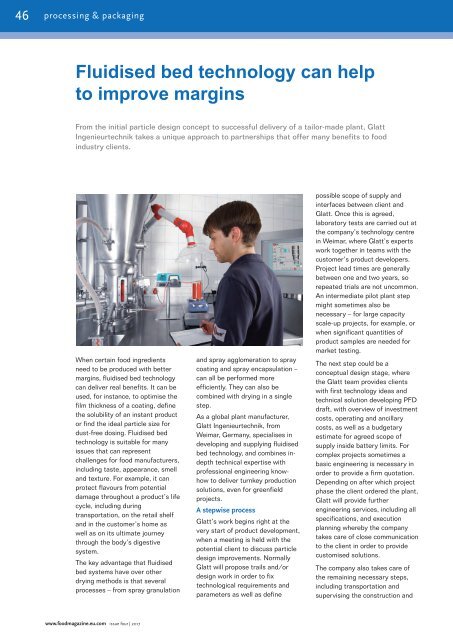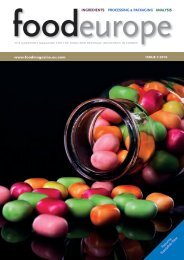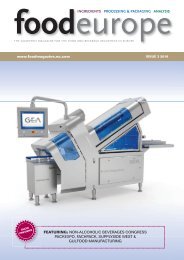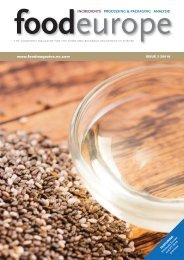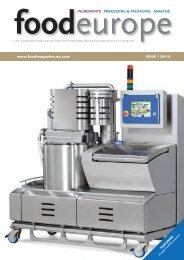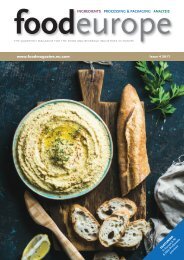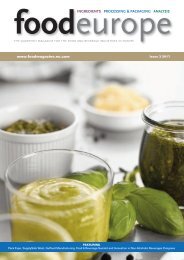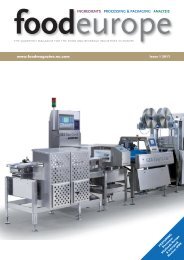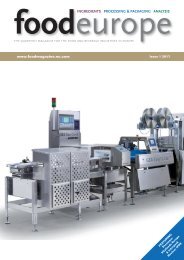Issue_4_2017_2
You also want an ePaper? Increase the reach of your titles
YUMPU automatically turns print PDFs into web optimized ePapers that Google loves.
46<br />
processing & packaging<br />
Fluidised bed technology can help<br />
to improve margins<br />
From the initial particle design concept to successful delivery of a tailor-made plant, Glatt<br />
Ingenieurtechnik takes a unique approach to partnerships that offer many benefits to food<br />
industry clients.<br />
When certain food ingredients<br />
need to be produced with better<br />
margins, fluidised bed technology<br />
can deliver real benefits. It can be<br />
used, for instance, to optimise the<br />
film thickness of a coating, define<br />
the solubility of an instant product<br />
or find the ideal particle size for<br />
dust-free dosing. Fluidised bed<br />
technology is suitable for many<br />
issues that can represent<br />
challenges for food manufacturers,<br />
including taste, appearance, smell<br />
and texture. For example, it can<br />
protect flavours from potential<br />
damage throughout a product’s life<br />
cycle, including during<br />
transportation, on the retail shelf<br />
and in the customer’s home as<br />
well as on its ultimate journey<br />
through the body’s digestive<br />
system.<br />
The key advantage that fluidised<br />
bed systems have over other<br />
drying methods is that several<br />
processes – from spray granulation<br />
and spray agglomeration to spray<br />
coating and spray encapsulation –<br />
can all be performed more<br />
efficiently. They can also be<br />
combined with drying in a single<br />
step.<br />
As a global plant manufacturer,<br />
Glatt Ingenieurtechnik, from<br />
Weimar, Germany, specialises in<br />
developing and supplying fluidised<br />
bed technology, and combines indepth<br />
technical expertise with<br />
professional engineering knowhow<br />
to deliver turnkey production<br />
solutions, even for greenfield<br />
projects.<br />
A stepwise process<br />
Glatt’s work begins right at the<br />
very start of product development,<br />
when a meeting is held with the<br />
potential client to discuss particle<br />
design improvements. Normally<br />
Glatt will propose trails and/or<br />
design work in order to fix<br />
technological requirements and<br />
parameters as well as define<br />
possible scope of supply and<br />
interfaces between client and<br />
Glatt. Once this is agreed,<br />
laboratory tests are carried out at<br />
the company’s technology centre<br />
in Weimar, where Glatt’s experts<br />
work together in teams with the<br />
customer’s product developers.<br />
Project lead times are generally<br />
between one and two years, so<br />
repeated trials are not uncommon.<br />
An intermediate pilot plant step<br />
might sometimes also be<br />
necessary – for large capacity<br />
scale-up projects, for example, or<br />
when significant quantities of<br />
product samples are needed for<br />
market testing.<br />
The next step could be a<br />
conceptual design stage, where<br />
the Glatt team provides clients<br />
with first technology ideas and<br />
technical solution developing PFD<br />
draft, with overview of investment<br />
costs, operating and ancillary<br />
costs, as well as a budgetary<br />
estimate for agreed scope of<br />
supply inside battery limits. For<br />
complex projects sometimes a<br />
basic engineering is necessary in<br />
order to provide a firm quotation.<br />
Depending on after which project<br />
phase the client ordered the plant,<br />
Glatt will provide further<br />
engineering services, including all<br />
specifications, and execution<br />
planning whereby the company<br />
takes care of close communication<br />
to the client in order to provide<br />
customised solutions.<br />
The company also takes care of<br />
the remaining necessary steps,<br />
including transportation and<br />
supervising the construction and<br />
www.foodmagazine.eu.com issue four | <strong>2017</strong>


